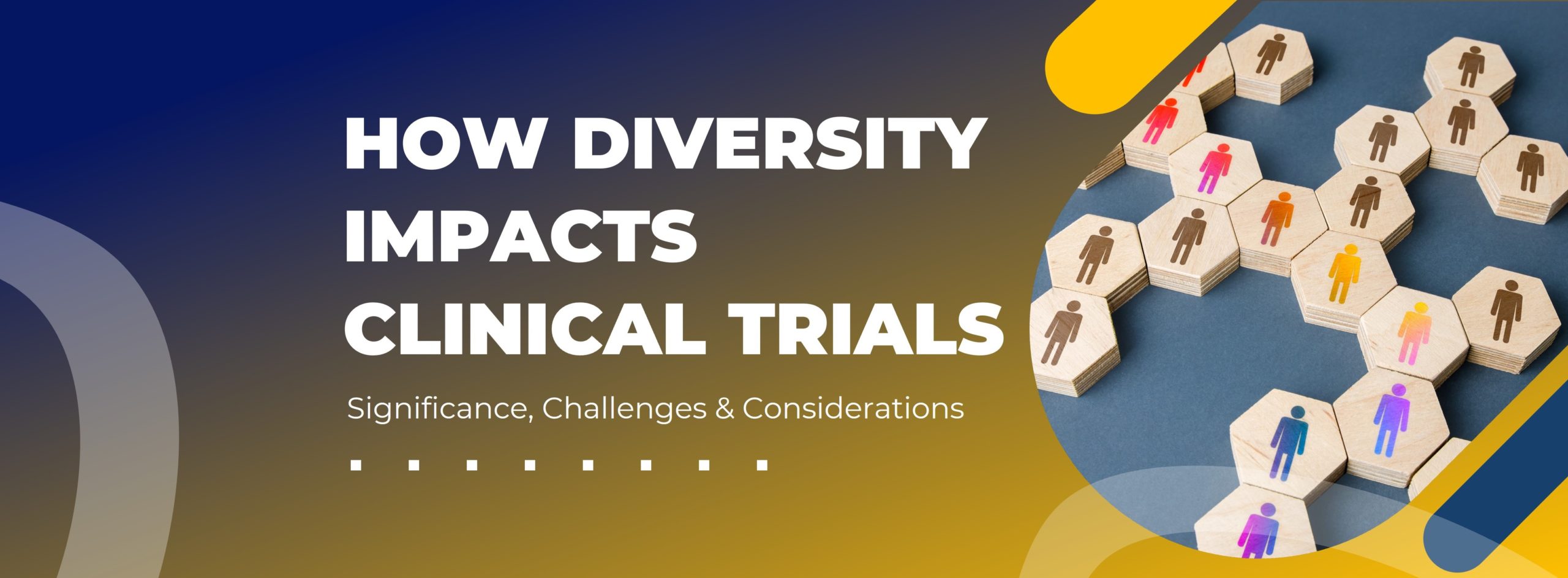
How Diversity Impacts Clinical Trials

How Diversity Impacts Clinical Trials
The lack of diversity in clinical trial populations has been a longstanding issue in the medical and research communities. While some researchers and advocates have been raising this concern for many years, in today’s rapidly evolving landscape of medical research and healthcare, the impact of diversity on clinical trials has garnered increasing attention.
In this article, we will explore how diversity affects clinical trials, the reasons behind its importance, and the steps that are suggested to ensure a more inclusive approach. In particular, we will focus on the various ways in which diverse participation can impact research outcomes, representation, and medical progress.
The impact of diversity on clinical trials cannot be underestimated, as a trial’s choices regarding representing a realistic variety of subjects and informed viewpoints influence the validity, applicability, and effectiveness of its outcomes.
Table of Contents
Significance of Diversity in Clinical Trials
Clinical trials serve as the cornerstone of medical research, guiding the development of new drugs, therapies, and treatment protocols. The conventional approach to clinical trials has traditionally often involved a relatively homogenous group of participants, which leads to challenges in extrapolating findings to broader populations and may miss important findings regarding factors that impact the outcomes of interest. However, this conventional model is damaging both to subjects and to trial results; it is vital to recognize that diversity isn’t just an ethical consideration but a scientific necessity.
Historically, clinical trials have predominantly included participants from specific demographics, such as white males of a certain age group. While this might be due to a desire to control variables and reduce statistical variability, it ultimately results in limited generalizability of the findings.
Diversity and inclusion in clinical trials are not mere buzzwords; they are integral to the validity and applicability of research findings. Not only does diversity reflect the real-world patient population that the medical intervention will eventually serve but people from different ethnicities, genders, age groups, and socioeconomic backgrounds can respond differently to treatments. Studies without a diverse participant pool will necessarily neglect these factors. This could mean missing crucial insights into a treatment’s efficacy, leading to potential disparities in treatment outcomes across different demographic groups.
Considerations for Diversity in Clinical Trials
Real-World Diversity
Clinical trials must mirror the diverse demographics of the real world to ensure that medical treatments work effectively across different populations. When participants in trials represent a broader spectrum of races, ethnicities, ages, genders, socioeconomic backgrounds, and other key demographics, the findings can be more generalizable and applicable to a larger segment of the overall patient population. When study samples are demographically limited, the results cannot be generalized outside of the population they represent; for example, a trial that enrolls almost entirely white subjects should not be considered generalizable to patients of other races without further study. Certain populations may experience different side effects or respond differently to specific treatments, which can only be revealed through diverse representation in the trials. In addition, other factors such as cultural beliefs, lifestyle choices and socioeconomic status can significantly impact how individuals respond to interventions. By considering these variables, researchers gain a holistic understanding of treatment effects, enabling them to refine and adapt medical approaches.
Addressing Health Disparities
Incorporating diversity in clinical trials is a critical step in addressing health disparities among various communities. Historically, marginalized groups have been underrepresented in medical research, leading to unequal access to treatments and healthcare services. There are also disparities with some diseases across populations. Diseases like diabetes, cardiovascular issues and certain types of cancer can have varying prevalence and impact across populations. Similarly, some marginalized groups show a significantly higher prevalence of neurologically-linked concerns such as post-traumatic stress disorder, anxiety, and depression. Clinical trials that include diverse participants enable researchers to understand the intricacies of these disparities and develop interventions that can effectively mitigate them. Furthermore, in the cases of rare diseases, recruiting a more diverse study population may improve study sample sizes if there is an increased representation of populations with a higher prevalence of the disease of interest.
Enhancing Drug Efficacy and Safety
A lack of diversity in clinical trials can result in drugs and therapies being developed without a full understanding of how they will affect different populations. Genetic, social, and/or cultural differences can influence drug metabolism and efficacy and without diverse representation, these nuances may be missed, potentially leading to adverse reactions or treatment inefficacy. When studies with limited patient populations are generalized to other populations, this may result in people being provided ineffective or dangerous treatments. Conversely, if a treatment shows positive efficacy in a marginalized population that is not included in a study, the results of the study will underestimate the treatment benefits due to its lack of diversity.
Tailored Treatments and Personalized Medicine
Diversity in clinical trials facilitates the development of personalized medicine. Certain genetic markers can influence drug metabolism, efficacy, and potential side effects. By including a diverse set of participants in clinical trials, researchers can better identify these genetic variations and tailor treatment approaches to specific genetic populations, ultimately leading to more effective and targeted medical interventions. This personalized approach paves the way for precision medicine, where treatments are optimized for each patient’s genetic makeup.
Inclusive clinical trials can also lead to the detection of rare side effects that may only manifest in specific populations. This knowledge is crucial for patient safety and post-approval monitoring of new treatments.
Improving Data Collection and Analysis
When studies plan for more diverse subject populations, it also can lead to better data collection and analysis. Considering a wider array of demographic and background factors during study design can require greater care in designing case reports and subject intake forms. It may also lead to more discussion among experts and statisticians about factors that are known or suspected to impact the conditions and treatments of interest to properly plan analyses and any study design decisions—such as stratification—to account for and investigate these factors.
Challenges in Achieving Diversity
The lack of diversity in many clinical trials is a multi-faceted issue, and so addressing this problem is a complex task. Historically, marginalized groups have been underrepresented due to barriers like lack of awareness, cultural mistrust and limited access to healthcare, as well as incidences of intentional exclusion to reduce study variance or due to bigotry. This lack of representation hinders the understanding of how different populations may experience a treatment’s benefits and potential side effects. What follows is a list of some of the more challenging aspects of achieving diversity in clinical trials.
- Lack of Representation in Trial Recruitment: One of the primary reasons for the lack of diversity in clinical trials is the challenge of recruiting participants from diverse backgrounds. Insufficient outreach and education about clinical trials within marginalized communities can hinder participation. Many individuals may not even be aware of the opportunities available to them due to insufficient advertising and active recruiting among certain populations. For businesses and organizations that regularly perform clinical trials, there may also be a sense of inertia that leads to using the same sites and investigators repeatedly; this may lead to increasingly repetitive and uniform populations if there is no regular evaluation of weak points in recruitment. Many trials face difficulties in reaching out to minority populations, leading to skewed representation in studies.
- Managing Language, Cultural Barriers, and Accessibility: A more diverse trial can involve additional logistics, such as accommodating different languages and cultural practices. Language barriers and cultural differences can discourage participation in clinical trials, especially among immigrant communities and people of marginalized races. Furthermore, there may be subjects with disabilities or other accessibility needs who require designing a trial to include them; as a familiar example, many trials require the informed consent statements to be read aloud to ensure subjects who cannot read or are visually impaired are not excluded. Questions to be considered can include the physical accessibility of sites, allowing virtual appointments or travel accommodations for subjects who do not have access to reliable transportation, and whether consent proxies can be utilized. Designing trials that are accessible and culturally competent for a more universal population can be complex but is essential for encouraging participation.
- Mistrust of the Medical System: For some marginalized groups, there may be dense historical context regarding the relationship to the medical system in their region; in many countries including the United States and Canada, for example, highly unethical experiments were and continue to be forcibly carried out on Black and indigenous community members. In addition, many marginalized groups continue to face discrimination, mistreatment, or gatekeeping when seeking medical care. This background of past and current maltreatment or mishandling from medical professionals has led to mistrust and skepticism towards clinical trials for some members of marginalized groups. Other challenges on this list – such as a study having a lack of accommodations for a given group – may feed back into this mistrust, reinforcing the belief that the medical system is apathetic or antagonistic.
- Lack of Representation in Trial Staff: Mistrust of the medical system and clinical trials among marginalized groups is exacerbated in studies where there are no researchers, investigators, doctors, or other trial staff who are of a similar background. For example, people of colour may be less inclined to consent to study participation or remain throughout the entire study if they only see white staff members, reinforcing a feeling that their needs and concerns aren’t being considered or recognized.
- Socioeconomic Factors: Socioeconomic disparities often limit access to healthcare, making it difficult for individuals from lower-income backgrounds to participate in clinical trials. In addition to direct limitations—such as a lack of health insurance and reliance on walk-in clinics or emergency rooms for treatment—other barriers may arise due to being socioeconomically disadvantaged. For example, transportation to a healthcare site may be reliant on public transit or other less reliable methods, or a study that utilizes a phone app for data collection may exclude subjects who cannot afford a personal smartphone. If not addressed, these barriers can result in a skewed representation of socioeconomic diversity.
- Geographic Disparities: Clinical trials are not evenly distributed geographically. Many trials take place in urban centers, which can exclude individuals living in rural or remote areas, impacting geographic diversity. Even trials that may include sites in more rural or remote areas may have diversity issues if there aren’t plans for travel accommodations—since public transit may be less accessible or nonexistent in these areas—and for planning around other socioeconomic and access factors.
- Health Disparities: Certain marginalized groups may experience higher rates of specific diseases or conditions. Addressing these health disparities and ensuring that relevant clinical trials are available to members of the groups who are most affected by the conditions being investigated requires extra planning and outreach.
- Sample Size Requirements and Study Timeline: A specific sample size is required to ensure sufficient power under the study assumptions. As efforts to improve diversity in a study sample—such as finding accessible sites or performing outreach to marginalized groups—may require greater time and resources, there may be concerns about reaching the planned sample size within the desired timeline for the study. Furthermore, sample size estimates may need to be rethought for more diverse populations, as historical references or past studies used in forming the sample size assumptions may be based on less diverse and more homogenous groups, artificially reducing their variability.
- Incentives and Compensation: Offering appropriate incentives and compensation for participation without exploiting vulnerable populations is a delicate balance to strike. For people with less socioeconomic privilege, monetary compensation for study participation may be a particularly compelling incentive, which means that ethical considerations around distorting subjects’ decision-making are especially relevant.
Overcoming these challenges is crucial to ensuring that clinical trial results represent and apply to a wide range of individuals, leading to more effective and equitable healthcare outcomes.
How to Improve Diversity in Clinical Trials
By actively seeking diverse participants, clinical trials can become more reflective of real-world populations, enhancing the relevance of the research. Various initiatives can be implemented to promote diversity. These include community engagement programs, culturally sensitive recruitment strategies, and partnerships with healthcare providers who serve marginalized populations. Here are further details on such initiatives.
- Design Inclusive Trials: Researchers should actively design trials that reflect a diverse population, including subjects of varying ages, genders, races, and socioeconomic statuses. One of the key ways this can be accomplished is by thoroughly considering the inclusion/exclusion criteria and questioning whether each criterion may be too broad or exclusionary for a group of marginalized people. For example, many trials have a broad exclusion criterion to allow investigators to determine whether subjects have a chronic condition that may interfere with the trial, with no further specification; such an exclusion criterion is likely to replicate existing biases by leaving decisions up to individual discretion or investigators choosing to exclude subjects who may seem too “difficult” to include. The process of designing inclusive trials should involve input from stakeholders among communities that are traditionally under-represented in clinical trials, to ensure that their needs are being addressed.
- Cultural Sensitivity: Designing trials that are culturally sensitive and respectful of diverse traditions and beliefs can be complex but is essential for encouraging participation. Researchers should be sensitive to practices and beliefs that might impact a participant’s willingness to engage in the trial. Efforts must be made to communicate trial information in languages accessible to different groups and provide cultural sensitivity in the trial process. It’s also important to consider places where cultural beliefs and sensitivities may impact subjects’ responses; for example, studies of sexually transmitted infections need to consider that certain groups may be more hesitant to self-report sexual behaviours if there are cultural restrictions around this topic. Extra efforts will need to be taken to ensure that subjects feel safe to honestly represent their experiences.
- Diversity of Research Team: Ensuring that investigation and medical staff reflect the diversity of the desired population can greatly increase trust and participation among marginalized groups. Not only can this assist in recruitment and outreach to subjects, but it can also increase data quality; members of marginalized groups may be more likely to provide more honest and detailed responses to investigators that match their demographics.
- Provide Accessibility: Ensuring that trials are comprehensively accessible is essential. Addressing geographic and financial accessibility involves offering transportation assistance, childcare, flexible scheduling and covering medical costs for participants who might face barriers. For other forms of accessibility, offering services and materials in a variety of languages, ensuring physical accessibility of sites, and providing both remote and in-person opportunities when possible will allow a wider variety of participants.
- Increasing Trust: Marginalized groups may be rightfully skeptical about participating in trials due to a lack of representation and medical mistreatment. By actively involving diverse participants and research staff, the medical community can encourage broader participation, leading to a more accurate representation of real-world scenarios. Establishing trust is vital to encourage diverse participation. Providing clear information about the trial, its purpose, and potential risks and sharing trial results helps build confidence among participants. Outreach to marginalized communities and education about medical and clinical opportunities should be ongoing and long-term, as trust can be slow to build and difficult to do on a short study timeline.
- Community Partnerships: The path towards more diverse clinical trials requires collaborative efforts amongst several organizations. Researchers, healthcare providers, policymakers, corporate centres, and community leaders should work together towards adequate representation of staff and stakeholders. Initiatives to increase diversity may involve raising awareness and the importance of available trials through targeted outreach to diverse communities, culturally sensitive strategies, addressing transportation concerns in accessing healthcare facilities and/or compensation for participants. Community input into needs and outreach efforts will improve knowledge of accessibility barriers and also help build trust among marginalized groups.
- The role of Regulatory Authorities: Regulatory authorities also have important roles in communicating and enforcing the importance of diversity in clinical trials. Regulatory agencies and authorities should continue and increase advocacy for inclusive representation and require evidence of diverse participant involvement before approving new treatments.
- Championing Ethical Considerations: Beyond scientific advancement, embracing diversity in clinical trials is rooted in ethical imperatives. Inclusion and respect for all individuals’ rights to access cutting-edge treatments are essential principles that should guide us all. When approaching each step of clinical trial planning and execution, the ethical prerogative of diversity should be one of the essential principles driving the process. Medical research and clinical trials are undertaken to improve the health and conditions of all, and our trials should reflect a similar devotion to overall representation and care.
Final Thoughts
Incorporating diversity into clinical trials is not just a moral imperative but a scientific one. It’s a fundamental cornerstone of research that empowers us to revolutionize healthcare. Diversity also extends far beyond the mere representation of different demographic groups; it encompasses a fundamental shift in each step of the clinical trial process to ensure that accommodating and serving all patients is central. Each of the demographic and background elements in a study sample contributes unique insights that collectively enrich our understanding of medical interventions and their effects across various populations. When medical interventions are tested on a representative range of individuals, we can more confidently extend the findings to larger populations. This enhances the scientific rigour of our research, allows for a more comprehensive understanding of treatments, identification of varied treatment responses, helps reduce health inequalities, and delivers more accurate treatment plans.
As researchers, healthcare providers, corporate entities, and regulators increasingly recognize the holistic importance of diversity, they must continue to dismantle the obstacles that stand in the way of achieving diversity in clinical trials. It is only by acknowledging and celebrating diversity that we can truly advance healthcare for the benefit of every individual and help ensure that no group is left behind in reaping the benefits of scientific progress. Diversity paves the way for personalized medicine, better overall health outcomes, and a fairer healthcare system that caters to the needs of a world of unique, multifaceted individuals.
Featured Posts
CONTACT
ALIMENTIV STATISTICS
Providing 40 years of service, Alimentiv Statistics is a niche Contract Research Organization focused on Biostatistics, Statistical Analysis, Clinical Trial Design and Data Management. We invite you to see how we exceed our clients’ expectations.


